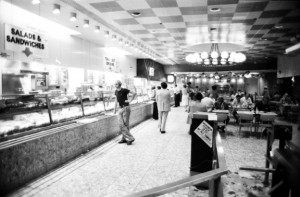Fast food franchise junk, escalating real estate prices, changing customs. These all knocked out the great New York cafeterias that fed old schmoozers, loquacious intellectuals, cab drivers, garment center workers, students, artists — everybody, in fact. In terms of cuisine, the best was Dubrow’s. There were three: one in the garment center (this was where HG dined before Knicks games at Madison Square Garden); one on Eastern Parkway in Brooklyn (where HG dined after watching Joe Klein, Floyd Paterson, Joey Giardello and other fighters at the Eastern Parkway Arena); another branch on Brooklyn’s Kings Highway (too quiet and staid for HG). All were decorated in high, post-Depression, “modernist” style with plenty of mirrored walls and pale, glistening wood. The garment center Dubrow’s (on Seventh Avenue in the 30’s) was a madhouse during weekday lunch hours. The wonder was how the cloak-and-suiters and skilled workers could eat so much and talk so much at the same time. The Eastern Parkway Dubrow’s was favored by Jewish bookmakers, horse players, gamblers, loan sharks and the last remnants of Brownsville’s Murder Inc. and associated Lepke mob. These were guys who favored expensive hats, sharp suits (by Brooklyn’s Abe Stark) and big cigars. A guy not wearing a suit, tie and hat was a “bum,” despised by all. By 1985 all the Dubrow’s were gone.
The Belmore Cafeteria on 28th Street and Park Avenue South (Fourth Avenue before the fancy name change) was a 24-hour-a-day place favored by cab drivers. Martin Scorcese’s movie “Taxi Driver” burnished its fame. The scenes between Robert DeNiro and Peter Boyle take place in front of The Belmore. Phil Siegel ran The Belmore for decades and never changed its motto: “New York’s Most Fabulous Restaurant.” Like Dubrow’s, it had plenty of Jewish and Eastern European specialties but there were many eclectic culinary surprises as well. It was always busy. At its peak, The Belmore fed some 5.000 New Yorkers every weekday. Siegel sold the cafeteria and its corner site in 1981 to developers of a “sliver” condo development.
A sad and quiet cafeteria was The Senate on Broadway and 96th. There were lots of tattoos there. No, not the multi-colored skin-scapes favored by today’s hipsters. These were the grim number tattoos of Holocaust survivors, men and women who conversed quietly over endless cups of tea. I.B. Singer, the Nobel Prize-winning Yiddish writer, was often there eating tuna salad (he also favored The Eclair,a middle European pastry shop and restaurant on W.72nd). Singer based many of his stories on the aged folks he met there — people whose stories bordered on the supernatural. There were two other groups at The Senate: junkies and hookers. The strung out junkies ate trays of the sweetest cakes they could find The hard working hookers favored more robust fare. They ate fast. Their demanding business agents didn’t like them taking too much time off.
The cafeterias of New York have vanished. Mickey Dee and the landlords have won.
